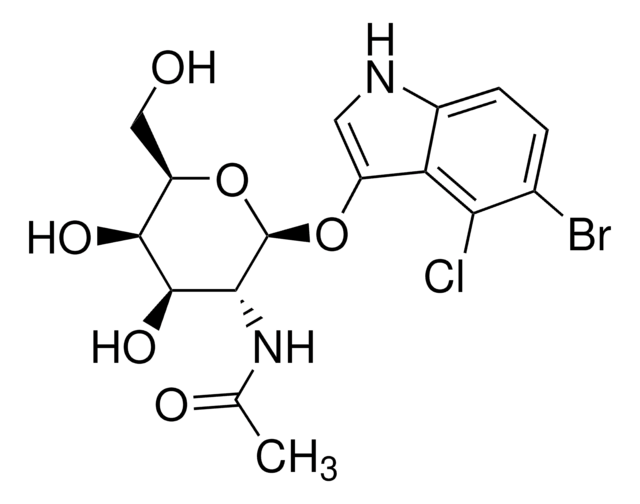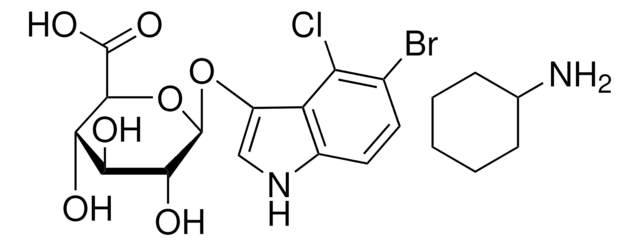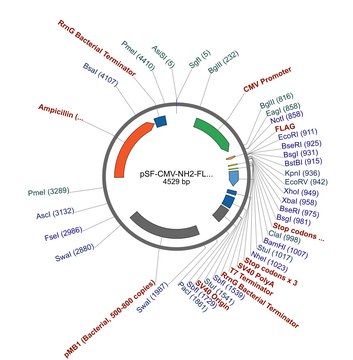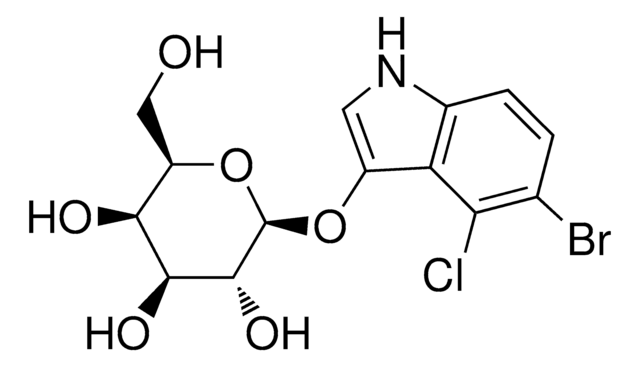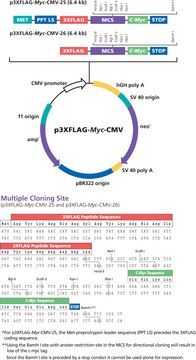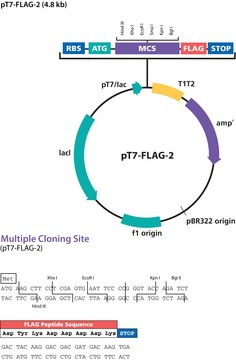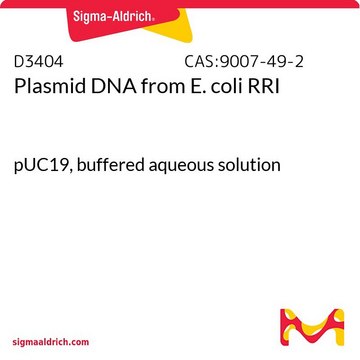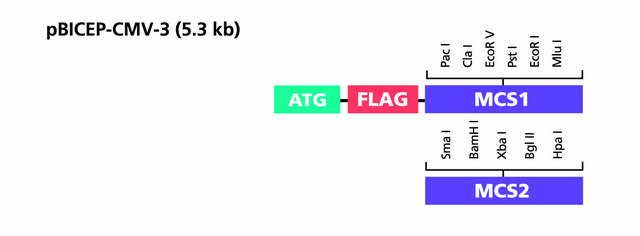E7283
p3XFLAG-myc-CMV™-26 Expression Vector
shuttle vector for transient or stable intracellular dual tagged expression of N-terminal 3xFLAG and C-term c-myc
Sign Into View Organizational & Contract Pricing
All Photos(3)
About This Item
UNSPSC Code:
12352200
Recommended Products
tag
3X FLAG tagged (N-terminal)
c-Myc tagged (C-terminal)
grade
for molecular biology
form
buffered aqueous solution
shipped in
dry ice
storage temp.
−20°C
General description
The p3XFLAG-Myc-CMV -26 Expression Vector is a 6.3 kb derivative of pCMV5 used to establish transient or stable intracellular expression of dual tagged N-terminal 3XFLAG and C-terminal c-myc fusion proteins in mammalian cells. The vector encodes three adjacent FLAG epitopes (Asp-Tyr-Lys-Xaa-Xaa-Asp) and a c-myc epitope (EQKLISEEDL) upstream and downstream of the multiple cloning sites, respectively. The third FLAG epitope includes the enterokinase recognition sequence, allowing cleavage of the 3XFLAG peptide from the purified fusion protein. The incorporation of 3XFLAG in the expression vector results in increased detection sensitivity using ANTI-FLAG M2 antibody. Efficiency of replication is optimal when using an SV40 T antigen expressing host.
The p3XFLAG-CMV-7-BAP Control Plasmid is a 6.2 kb derivative of pCMV5 used for transient intracellular expression of N-terminal 3X-FLAG bacterial alkaline phosphatase fusion protein in mammalian cells. The vector encodes three adjacent FLAG epitopes (Asp- Tyr-Lys-Xaa-Xaa-Asp) upstream of the multiple cloning region. This results in increased detection sensitivity using ANTI-FLAG M2 antibody. The third FLAG epitope includes the enterokinase recognition sequence, allowing cleavage of the 3XFLAG peptide from the purified fusion protein.
Vector Maps and Sequences
The p3XFLAG-CMV-7-BAP Control Plasmid is a 6.2 kb derivative of pCMV5 used for transient intracellular expression of N-terminal 3X-FLAG bacterial alkaline phosphatase fusion protein in mammalian cells. The vector encodes three adjacent FLAG epitopes (Asp- Tyr-Lys-Xaa-Xaa-Asp) upstream of the multiple cloning region. This results in increased detection sensitivity using ANTI-FLAG M2 antibody. The third FLAG epitope includes the enterokinase recognition sequence, allowing cleavage of the 3XFLAG peptide from the purified fusion protein.
Vector Maps and Sequences
Components
- p3XFLAG-myc-CMV™-26 Expression Vector 20 μg (E6401) is supplied as 0.5 mg/ml in 10 mM Tris-HCl (pH 8.0) with 1 mM EDTA.
- p3XFLAG-CMV™-7-BAP Control Plasmid 20 μg (C7472) is supplied as 0.5 mg/ml in 10 mM Tris-HCl (pH 8.0) with 1 mM EDTA.
Principle
The promoter-regulatory region of the human cytomegalovirus drives transcription of FLAG® and c-myc fusion constructs. The aminoglycoside phosphotransferase II gene (Neo-r) confers resistance to aminoglycosides such as G 418 allowing for selection of stable transfectants.
Legal Information
This product is covered by the following patents owned by Sigma-Aldrich Co. LLC: US6,379,903, US7,094,548, JP4405125,EP1220933, CA2386471 and AU774216.
FLAG is a registered trademark of Merck KGaA, Darmstadt, Germany
p3xFLAG-CMV is a trademark of Sigma-Aldrich Co. LLC
p3xFLAG-Myc-CMV is a trademark of Sigma-Aldrich Co. LLC
Storage Class Code
12 - Non Combustible Liquids
WGK
WGK 3
Flash Point(F)
Not applicable
Flash Point(C)
Not applicable
Personal Protective Equipment
dust mask type N95 (US), Eyeshields, Gloves
Regulatory Information
新产品
Choose from one of the most recent versions:
Certificates of Analysis (COA)
Lot/Batch Number
Don't see the Right Version?
If you require a particular version, you can look up a specific certificate by the Lot or Batch number.
Already Own This Product?
Find documentation for the products that you have recently purchased in the Document Library.
Tania R Lizarbe et al.
FASEB journal : official publication of the Federation of American Societies for Experimental Biology, 22(9), 3207-3215 (2008-05-23)
Nitric oxide (NO) plays a critical role in wound healing, in part by promoting angiogenesis. However, the precise repair pathways affected by NO are not well defined. We now show that NO regulates matrix metalloproteinase-13 (MMP-13) release during wound repair.
William Stedman et al.
Journal of virology, 78(22), 12566-12575 (2004-10-28)
The viral genome of Kaposi's sarcoma-associated herpesvirus (KSHV) persists as an extrachromosomal plasmid in latently infected cells. The KSHV latency-associated nuclear antigen (LANA) stimulates plasmid maintenance and DNA replication by binding to an approximately 150-bp region within the viral terminal
Zhi Sheng et al.
Nature medicine, 16(6), 671-677 (2010-05-25)
Activating transcription factor-5 (ATF5) is highly expressed in malignant glioma and has a key role in promoting cell survival. Here we perform a genome-wide RNAi screen to identify transcriptional regulators of ATF5. Our results reveal an essential survival pathway in
Patrick Lorès et al.
The FEBS journal, 277(6), 1453-1464 (2010-02-13)
The SWI/SNF chromatin remodelling complexes are important regulators of transcription; they consist of large multisubunit assemblies containing either Brm or Brg1 as the catalytic ATPase subunit and a variable subset of approximately 10 Brg/Brm-associated factors (BAF). Among these factors, BAF60
Hongbo Fang et al.
PloS one, 8(7), e69600-e69600 (2013-07-31)
Breast cancer occur both in hereditary and sporadic forms, and the later one comprises an overwhelming majority of breast cancer cases among women. Numerical and structural alterations involving chromosome 8, with loss of short arm (8p) and gain of long
Our team of scientists has experience in all areas of research including Life Science, Material Science, Chemical Synthesis, Chromatography, Analytical and many others.
Contact Technical Service
